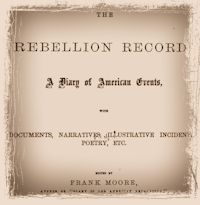November 1, 1863.
A plot to liberate the rebel prisoners in Ohio was discovered, and several parties to it were arrested. It was concerted that on a given night, which had not been definitely fixed, a sufficient number of the conspirators were to assemble in the vicinity of Camp Chase, and at a known signal were to overpower the guard, (which was far from being a strong one,) and at the same time the prisoners, who were to be apprised of what was going on, and who numbered about four thousand, were to make a rush from the inside, and thus secure their freedom. Having armed themselves with the weapons of the guard, they were then to march on Columbus, and seize the arsenal, arming themselves completely with the United States arms stored there. From thence, their next attack was to be on the Penitentiary for the release of John Morgan and his men, by whom the rebel army in Ohio was to be officered. Then the rebel campaign in Ohio was to be commenced, and the first proceeding on the part of the traitors was to be the cutting of the telegraph wires and the burning of the railroad-bridges, in order to prevent the arrival of National troops.
The parties involved in the matter were very numerous, and were to be found in almost every part of the State, some of them occupying positions under the United States and State government, which rendered it a somewhat easier task for the detectives to gain access to the nest of traitors. The leading man in the conspiracy was Charles W. H. Cathcart
A party of guerrillas, under Campbell, entered Charleston, Missouri, night before last, and after robbing the stores and private houses, retreated, carrying away with them Colonel Deal.—Charles R. Ellet, commanding the Mississippi Marine Brigade, died, at Bunker Hill, Illinois, on Thursday last, October twenty-nine. —Jay Cooke, the subscription agent of the United States Government, reported the sales of over thirty-six millions of five-twenty bonds during the previous week.
—The following official communication from Provost-Marshal General James B. Fry, to Colonel Robert Nugent, Assistant Provost-Marshal of New-York, was made public:
“The representations made by Dean Richmond and Peter Cagger, in a printed circular, dated October twenty-seventh, 1863, in respect to the action of the Provost-Marshal General, are untrue.
“It is not true that the State of New-York is charged as with a deficiency for every citizen who has paid the three hundred dollars commutation money, receiving no credit therefor. On the contrary, the State receives the same credit for a man who has paid commutation as if the drafted citizen had gone in person or furnished a substitute; and in like manner towns which had raised the money to pay their quotas receive the same credit as if actual substitutes had been furnished.
“And the President has ordered, that every citizen who has paid the three hundred dollars commutation shall receive the same credit therefor, as if he had furnished a substitute, and is exonerated from military service for the time for which he was drafted, to wit, for three years.
“As the misrepresentations of Dean Richmond and Peter Cagger have been published and circulated for electioneering purposes, it is proper that you give them immediate correction.”
—The bombardment of Fort Sumter continued without cessation. Yesterday morning, a portion of the wall fell in, burying beneath the ruins some men of the Twelfth Georgia and Twenty-fifth South-Carolina. Thirteen were buried by the falling in of the barracks on the sea-face of the Fort. Over one thousand two hundred shots were fired in twenty-four hours — the shots averaged four per minute. The firing was from two monitors—two heavy and two light rifled guns at Fort Gregg, four ten inch mortars at the middle battery, and four rifled guns at Fort Wagner.



